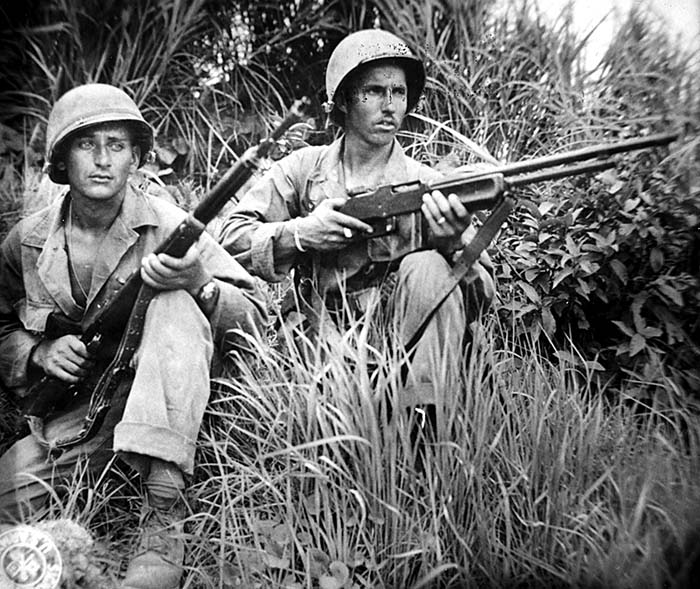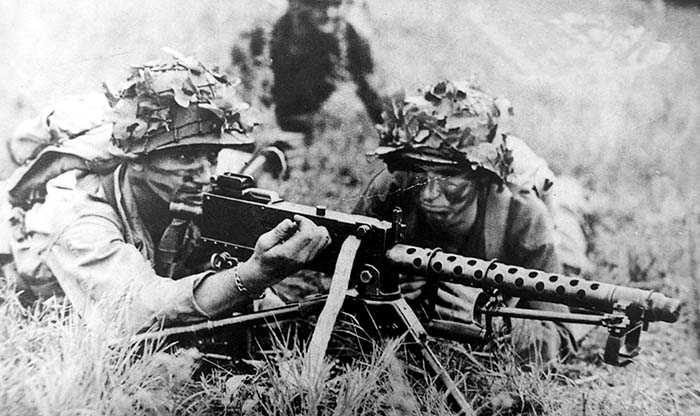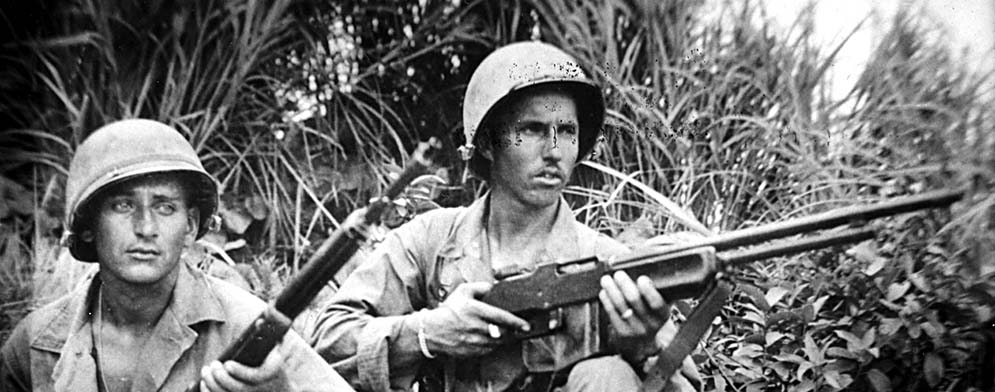By Frank Iannamico
One of the US Ordnance Committee’s responsibilities was to “consider and recommend technical action upon all matters affecting material designed for, and to be issued to the armed forces, coming within the jurisdiction of the Ordnance Department”. Small arms of course were covered under this directive. The Ordnance Committee met regularly to discuss weapons and related subjects.
Marine Lt. Colonel V.H. Krulak was asked to attend an Ordnance Committee meeting that was held on 23 December, 1943, to give some feedback to the Committee on how some of the weapons were performing in the field. Colonel Krulak had just returned from fighting the Japanese in the Pacific Theatre, including Guadalcanal, the United States’ first major offensive operation of the war. Below is a transcript of that meeting, his comments on the performance of several weapons is very interesting.
Please note: The grammar and verbiage of the transcript has not been edited or corrected.
Chairman of the Committee General Barnes: “Lt. Colonel V.H. Krulak, Marine Corps, has been in the South Pacific for 18 months, is back, and has agreed to talk to us this morning about some of his experiences. I know some of you probably have appointments, so you can consider the meeting adjourned, and those who wish to stay to hear Colonel Krulak’s remarks we would very much like to have you stay. Those who feel they must go, I suggest that you leave now so as not to disturb Colonel Krulak… I guess everybody wants to hear you Colonel, I don’t see any volunteers. We will turn the meeting over to Colonel Krulak”.
Colonel Krulak: “Thank you General. I reckon I represent from your viewpoint, the other end of the horn. You produce these things on the basis of recommendations and your own mental cerebrations, and then we use them. A matter of weeks ago the task force under my command was busily engaged in destroying Japanese with those items of equipment. Colonel Hussa though it might be of interest to you to have a first hand description of their performance with certain comments on things we might further produce to facilitate our destruction of the Japs. The Marine Parachute Troops, whom I am associated with, are primarily of course, a small arms organization; and my remarks of Ordnance performance will be confined for the most part to that type of weapon. These are the weapons with which we are normally armed, and which I have observed to some extent in combat with the enemy.
The U.S. Rifle Caliber .30 M1- It is magnificent. We will stop there.
The Johnson Rifle- With which I am sure some of you are familiar. Fabricated by the Johnson Arms Company. It is satisfactory. We are not procuring any more in the Marine Corps, so it is not a matter of particular interest.
The Reising Sub-Machine Gun Caliber .45-This as you probably know is a folding stock parachute model .45 caliber weapon, built as a replacement for the Thompson gun. Later models which have been accurately fabricated are quite satisfactory. They function well and as the .45 goes it is quite acceptable. However, I would like to interject for my part I never want to see .45 caliber weapons in the jungle. The Japs are not afraid of them, they do not make enough noise, and the bullet does not go far enough through the heavy undergrowth. They spend themselves rapidly and the weapon and ammunition together are too heavy to warrant them being taken. The men throw them away.
The Thompson Sub-Machine Gun- The same remarks apply, magnified. It is much too heavy, it is uncomfortable to carry and it does not function well. I know the Russians like it, but I believe they just don’t know any better. It does not function well in the jungle. It does not stand up. That is a generality, I suppose I should expound on this a little bit. When I say they do not stand up, they do not react well to the destructive effect of continued immersion. As you know, small arms consume quantities of powder which makes a dandy paste with water and sand, and presently the automatic function is destroyed.
The Browning Automatic Rifle- A very fine weapon, but just like the P-40, it is in our mind outmoded. It is a dead duck. It was practically replaced in my command by a weapon erroneously termed the Johnson Light Machine Gun. This Johnson Light Machine Gun is in actuality a machine rifle comparable in all tactical respects to the B.A.R. But, it is lighter, lighter by pounds, lighter lets say by 100 rounds of caliber .30 ammunition on a soldier’s back. It functions miraculously well under the most adverse circumstances. It is accurate. Now I am attempting to say in correct terms, that because of the splendid sight, as compared with a very questionable one in the case of the B.A.R., and because of an action which results in the bullet being on its way before the machinery starts to work you can destroy snipers with it in a single shot. You can provide full support in the reduction of pill boxes, bunkers, and fixed defenses. Troops will not go in under a B.A.R. because it is not sufficiently precise because of its sight and inherent action. I believe that you are doing something about the B.A.R. action. I should be delighted to see it, and while you are doing it, take five pounds off of it. It will then be comparable to the, I dare say, to this machine weapon called the Johnson Light Machine Gun with the exception to its functioning. Side by side we found the Johnson Light Machine Gun to function more dependably.

The U.S. Rifle Caliber .30 M1903- We have them only because we had no other vehicle on which to mount the anti-tank launchers and the remarks with regard to that weapon are the conventional ones-utterly dependable, extremely accurate, very valuable.
The Carbine- My organization being parachutist was equipped with the carbine folding stock, and we found it to be a most effective weapon. It is of sufficiently high velocity to drive its way through the heavy jungle foliage. It is accurate, and most of all, it is light and comfortable, 75 rounds of it on your person leaves you entirely free to carry anything you wish. You don’t even know you have it. The men have confidence in it and it works well. It works extremely well under arduous conditions. I understand that there have been adverse comments on this weapon from the European Theatre to the extent that it lacks precision at ranges in excess of 400 yards. I am entirely ignorant of such circumstances because I have never seen one fired at over 50 yards, at which range they are a splendid weapon. There is a need for carbine tracer ammunition, at first I was required to arm all squad leaders with rifles so that they could use .30 tracer for target designation. If we had carbine tracer, they would have naturally been armed with a carbine, thereby giving them a good deal more mobility. I am told such a thing exists but that the requirement has been rather low, I cannot see why, and I only urge that some thought be given to the distribution. You know that people in the field sometimes do not know what is going on. I didn’t know such a thing existed; and therefore never asked for any. If it had been even hinted that such a thing existed, I dare say, many jungle units would ask for caliber .30 carbine tracer ammunition.
The Bazooka- We used it as an anti-barge weapon against Jap landing barges. I reckon you look upon that as makeshift, but it did an extremely credible job. One round of bazooka ammunition in a Jap landing barge and its all over. Unfortunately you have to get pretty close as they are armed with twin 50’s and on some occasions with twin 20’s, and they take effective measures sometimes to prevent you from getting close. We also use it against pill boxes and bunkers in the embrasure attack, and it is, as you may guess, quite as effective as the M9A1 Grenade and a bit more accurate at ranges exceeding 50 yards. But we condemned it in principal for that particular task for the reason that when do not use it as a bazooka you do not use it at all. Now with the anti-tank grenade on the rifle you still have an effective small arms weapon. We used them (bazookas) but the next time we will leave them behind.
At this moment I would like to interject that weight, even down to ounces, is a critical thing. The men are taxed to their physical utmost to the extent unless they are highly disciplined they will throw essentials away. On occasion it is pretty hard to set yourself to the task of coercing a man to hang onto something that you yourself feel he is not going to use.
It has come to my mind at the moment that I have done Mr. Browning a dreadful injustice in omitting one of the finest pieces of ordnance that has ever been designed, and that is the 1919A4 Light Machine Gun, which we used to prodigious effect. It is the most dependable weapon that ever came down the road. My only comments are those of humility. I am a member of the determined and belligerent school, which says, I repeat, which says we have no need for a water-cooled machine gun so long as we have that splendid weapon (1919A4) in our possession”.

General Barnes: “Any comments, questions? (None) Thank you very much Colonel Krulak”.
| This article first appeared in Small Arms Review V4N3 (December 2000) |











